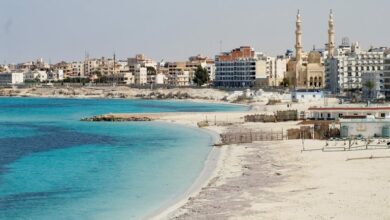Reminiscing over the past ten years of frequent trips to the strip of bright blue sea and white sand that lies north-west of Cairo, memories come rushing back, along with a realization of the many social trends that Egypt’s North coast, or “Sahel,” has endured.
It seems that exclusivity, or perhaps the obsession with it, has been responsible for moving people from one resort to another; or from one “hang-out” to another within different resorts, driving investors to pool their resources into what had previously been a lesser-known area of Egypt.
Now casually referred to as the North Coast, the coastline between Alexandria and Marsa Matrouh extends for around 290km and harbors a number of resorts, ranging from the high end, where the “creme de la creme” of Egyptian society spend their summer holidays, to the extremely low end, where those who provide services at the resorts spend their nights in cockroach-infested dwellings.
I came to know Marina, the largest–and by far the most famous–of the A-class resorts, in 1997. In the early 1990s, it was almost an unheard of haven for rich government ministers, businessmen and people who could afford its pricey chalets and villas.
The beach was free. The restaurants were limited, and there was a single night club. The community was small, and intruders on this upper-class society very few. Everyone seemed to be connected through a tight network of family, friends and friends of friends. Beach buggies, jet skis, expensive boats and luxury cars could be found in abundance.
By the end of the 1990s, however, much of this had changed. People had already moved to extensions of the resort, fleeing the eyes of the “renters”–an expression Marina residents use often.
As word spread about Marina, it attracted more attention, and soon many residents were renting out their chalets and apartments. However, this seemed to invite holidaymakers from a lower socio-economic class. The divide between renters and original tenants became increasingly stark.
Marina’s long lake soon became a favorite spot for jet-ski owners, which led to a number of accidents–and a reputation for danger that pushed people away from the area.
The hip crowd soon escaped to Nadi el-Sayarat, the “Auto Club,” another strip of beach. There, a person had to be well-connected in order to belong to the cool crowd, members of which would often hang out on the small beach by the pier.
If you were “super cool”–in this micro-community’s estimation–you would make an entrance in a four-wheel-drive vehicle with huge amps playing the latest pop hits. A dog would be second on the list of must-haves: Boys usually had black Rottweilers or golden retrievers, while girls sported petite Chihuahuas and Griffons. Of course, the smaller creatures got on the bigger ones’ nerves, and this was how boys and girls hooked up back then.
At the time, places for hanging out in the evenings were limited, and people usually ended up spending most of their nights dancing away in Havana, an obscure night club near the famous Sea Gull fish restaurant in Marina’s shopping area.
“Havana was always empty, but this never stopped the bouncer from giving the clientele a bit of attitude before they entered,” says Mohamed Rahmy, a friend of mine, recalling his nights out in Marina in the mid 1990s.
Saber, an ice-cream shop, was another hot spot. The place would only start filling up around midnight and people kept pouring in until 4:30 AM to quell their nocturnal cravings for shisha and rice pudding.
There was nothing else special about Saber except the crowd–everyone worth knowing would be there. So if you wanted to spot someone–or simply wanted to be seen–Saber was the place.
But again, it soon attracted the attention of a less desirable crowd: the unwanted middle-class “renters,” forever carrying the stigma of not owning a place in Marina.
And so other night spots soon popped up. Coffee-shops, beer bars and more expensive, Agami-style restaurants became all the rage.
A certain segment of the community, however, continued to insist on its exclusivity, prompting a migration away from particular spots of beach, nightclubs and restaurants. With this came the introduction of beach fees, which were made private to shelter them from prying eyes.
The opening of La Plage marked the beginning of this trend. In order to make it to the white sandy beach of La Plage, you had to be a member, or else know someone who was. Back then, I learned how to sneak in while still looking cool.
A pass for La Plage would cost around LE500, and in order to get one you had to be a Marina resident.
Another trend surfaced a couple years later: female-only beaches. La Femme was a pioneer in this area. Its beach-goers are usually veiled women who appreciate a good swim and want to tan without being hit on or annoyed by intruding eyes.
As Marina expanded every year, more people kept flooding in, and it was time for more outlets. This is when heavy investment came in, with a deluge of restaurants and cafes opening in Marina and its extension, around ten kilometers along the coastline.
Then a new concept was introduced to the area: the club house. In 2006, Cancun opened its doors to eager visitors. In the morning, people would chill out by the pool; at night, shisha and drinks were the main attraction. Cancun did not make it through its first summer, but was quickly replaced by other exclusive club houses.
All this left its mark on the Marina community, and the early 2000s saw a major property-selling trend. The hip area was moving again, but this time it was to be outside Marina altogether.
Within the last three years especially, beach destinations and outings have been dispersed, and very few people now swim in Marina.
“In the last two years, we’ve been swimming by a friend’s house in Marina 5, the extension, by the Ministers’ Pier,” says A., as Marina has become too crowded.
The influx of investors and the spawning of resorts all the way to Sidi Abdel Rahman have provided an array of options for sea lovers and have stolen the spotlight from the now-overgrown resort of Marina, once the gem of the North Coast.
The new resorts, closer to Sidi Abdel Rahman than they are to Alexandria, offer exclusivity lovers a new hideaway: Hacienda, with its clear turquoise waters, may prove to be one of the main attractions (rumor has it that presidential scion Gamal Mubarak owns a place there).
You can’t pay entry fees for Hacienda–one is usually asked at the gate to provide the name of a friend and his or her house number. The security guard then contacts that person to make sure he or she is expecting you.
One visitor to Hacienda recalls how he was reminded that he didn’t belong: “I went to buy lunch for my four-year-old at the beach bar, but was denied services because I was not a Hacienda resident,” says Ahmed Senna.
In short, over the last ten to 15 years, the North Coast community has witnessed tremendous change–for better or worse.




